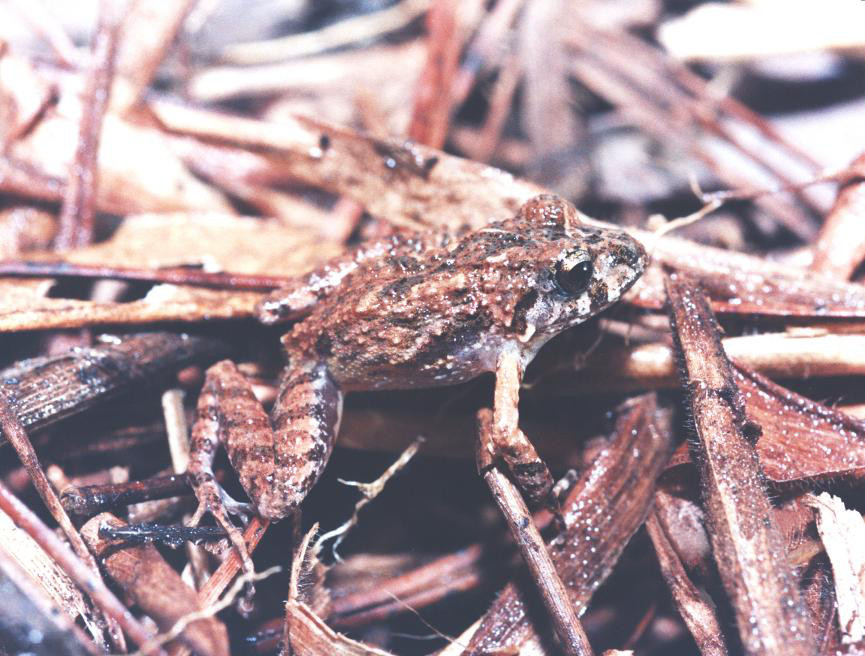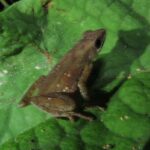- Introduction: The Quiet Charm of Ischnocnema juipoca
- Taxonomy and Classification: Unpacking the Identity of Ischnocnema juipoca
- Natural Habitat: The Forest Floor's Secretive Dweller
- Physical Characteristics: Master of Subtlety and Camouflage
- Behavior and Life Cycle: Unraveling the Quiet Routines of Ischnocnema juipoca
- Ecological Role: Spotlighting an Integral Ecosystem Guardian
- Threats and Conservation Status: Safeguarding a Fragile Existence
- Cultural and Scientific Significance: Insights Beyond Their Size
- Conclusion: Cherishing an Elusive Jewel — A Call to Action
Introduction: The Quiet Charm of Ischnocnema juipoca#
Hidden discreetly beneath layers of moist leaf litter and concealed amidst patches of lush vegetation, a tiny vigilante of Brazil’s Atlantic Forest patiently waits. Rare is the wanderer who notices its silent vigil, interrupted only occasionally by faint rustlings as insect prey unwittingly crosses its path. Meet the Ischnocnema juipoca, a diminutive yet significant frog species whose subtle presence tells profound stories about its habitat health and biodiversity.
Ischnocnema juipoca—a name as intricate as it is melodious—belongs to the family Brachycephalidae, known for their direct development, bypassing the tadpole stage entirely. This unique frog offers compelling clues about environmental conditions and urgently reminds us of the delicate balance within Brazil’s imperiled ecosystems. But beyond this ecological significance lies an enchanting story: a tiny amphibian thriving quietly, beautifully adapted to life amongst shadows.
Taxonomy and Classification: Unpacking the Identity of Ischnocnema juipoca#
Scientifically categorized as Ischnocnema juipoca, this species falls within the family Brachycephalidae, genus Ischnocnema—a group known notably for their direct development and intricate camouflage adaptations. First described in clear scientific detail in the late 20th century, I. juipoca embodies a remarkable evolutionary trajectory shaped profoundly by specific geographic and ecological pressures of Brazil’s Atlantic Forest biome. Researchers often find this species grouped alongside close relatives within the genus, such as Ischnocnema guentheri and Ischnocnema henselii, each adapting across slightly differing niches.
The careful classification of I. juipoca helps researchers understand biodiversity patterns in rapidly shrinking ecosystems. Species distinction, like tiny brushstrokes on a massive conservation canvas, amplifies the urgency of protecting unique habitats crucially threatened by human-induced environmental changes.
Natural Habitat: The Forest Floor’s Secretive Dweller#
Ischnocnema juipoca finds sanctuary within the remains of Brazil’s Atlantic Forest, notably within southeastern regions extending into Minas Gerais, Espírito Santo, and adjacent areas. This rich region, characterized by lush rainforest canopy and humid understory, provides a perfectly balanced microclimate critical to the frog’s survival. Dense leaf litter scattered beneath towering trees serves as crucial substrates where moisture, shelter, and prey intersect.
Within this vibrant ecosystem, temperature remains moderately consistent, and humidity levels soar, enveloping the ground in perpetual dampness. Such an environment is ideal for amphibians like I. juipoca, which must consistently maintain skin moisture to breathe and absorb vital nutrients through their permeable skin. By night, fog rolls silently through trees, enhancing humidity, while by day the dense canopy filters sunlight, keeping the forest floor shadowed, cool, and welcoming for this inconspicuous species.
Yet it’s here, amid a damp tapestry of decomposing leaves, moss-covered rocks, and tangled roots, that Ischnocnema juipoca orchestrates its life. This quietly rich and meticulously balanced environment provides not only safety and sustenance but offers ample camouflage, keeping predators—and curious researchers—at bay.
Physical Characteristics: Master of Subtlety and Camouflage#
Measuring merely two to three centimeters at adulthood, the Ischnocnema juipoca holds its secrets close through its physical characteristics. At first glance, its body appears drab and unassuming—exactly the intended effect. Shades of brown, gray, and olive blend seamlessly with leaves, rotting wood, and damp earth, helping this frog evade both predatory gaze and human curiosity.
On closer examination, intricate patterns emerge. Delicate darker stripes crisscross its limbs, while specialized granular skin textures, essential for efficient water absorption, lend them an earthy, mottled appearance. Eyes large relative to a small head allow exceptional nocturnal vision, crucial for precise hunting beneath dimly-lit understory conditions. The rounded snout and compact body afford efficient navigation through tight leaf litter spaces—traits exquisitely adapted over generations seeking stealth and security.
Behavior and Life Cycle: Unraveling the Quiet Routines of Ischnocnema juipoca#
Unlike many amphibians with elaborate nightly choruses, Ischnocnema juipoca leads a quieter existence. Mating calls, essential for partner attraction, come softly—subtle chirps and clicks emerging primarily at dusk, blending gently with the rhythm of insect hums and whispers of forest leaves. Against this backdrop, females and males converge secretly beneath leaf debris, initiating courtship behaviors rarely courageously unveiled to human observers.
Couples engage quietly, and soon after fertilization, rather than laying eggs in streams or pools, females attach their small, transparent egg clusters beneath securely hidden leaf litter or sheltered crevices. Here unfolds a remarkable adaptation: direct development. Within those sheltered eggs, tadpoles transform entirely, foregoing aquatic stages and emerging directly as miniature versions of adult frogs. This strategy cleverly bypasses vulnerable aquatic larval stages, granting juveniles immensely improved odds of survival amid predatory risks present in water.
Once developed, juvenile frogs emerge fully terrestrial, instinctively thriving among layers of citrus-rich leaf litter and damp microhabitats. Feeding primarily upon ants, termites, tiny beetles, and other small invertebrates inhabiting forest floors, their hunting style mirrors their overall secrecy: patient ambushes coupled with precision strikes, ensuring energy efficiency critical for survival in intensively competitive habitats.
Ecological Role: Spotlighting an Integral Ecosystem Guardian#
Though diminutive, Ischnocnema juipoca functions as a critical ecological lynchpin within Brazil’s threatened Atlantic Forest ecosystems. As voracious consumers of insects and small arthropods, they help regulate invertebrate populations, curbing potential pest outbreaks and maintaining the delicate ecological equilibrium essential to forest health. In turn, they occupy crucial positions as important prey items themselves, nourishing birds, snakes, larger amphibians, and small mammals, thus securing vital energy flow across multiple trophic levels.
Moreover, the sensitivity of this species’ skin—which rapidly absorbs environmental toxins and moisture—renders them excellent bio-indicators. Changes in their population size, health, or distribution indicate significant ecological shifts or pollutants, providing vital early warnings about environmental deterioration long before more apparent signs evolve. A quiet sentinel indeed, but one worth keenly listening to.
Threats and Conservation Status: Safeguarding a Fragile Existence#
Today, the resilient yet fragile existence of Ischnocnema juipoca faces unprecedented challenges. Habitat fragmentation and deforestation related primarily to agricultural expansion, logging, urbanization, and infrastructural developments have significantly impacted the quality, availability, and continuity of its specialized habitats. The Atlantic Forest, historically vast, has shrunk dramatically—today a mere fraction of its original extent remains, scattered in dense patches amid human-altered landscapes.
Climate change exacerbates these stresses, altering rainfall patterns and temperature, thereby destabilizing microhabitats essential for frog reproduction and survival. Collectively, these pressures render preservation of this delicate species—currently recognized as “Data Deficient” by the IUCN Red List, reflecting insufficient precise data—especially urgent.
Fortunately, several conservation initiatives are actively combating these threats. Designation of protected forest areas, restoration projects connecting forest fragments, and increasing public awareness efforts strive toward a more stable future for these remarkable frogs—and countless other co-inhabiting species.
Cultural and Scientific Significance: Insights Beyond Their Size#
While not commonly prominent in folklore or cultural symbolism, the significance of amphibians like Ischnocnema juipoca grows strongly within scientific contexts. Scientists increasingly value them for their sensitivity as vital climate and environmental indicators. Research into their unique biological adaptations—particularly direct development—also unlocks broader evolutionary insights applicable across ecological and conservation sciences.
Beyond scientific interest lies a more profound symbolism. Ischnocnema juipoca represents resilience, delicacy, and adaptability—quiet reminders of nature’s wonder, intricacy, and vulnerability in rapidly changing technological and social landscapes. Their survival journey mirrors the broader call for harmonious coexistence with nature, prompting greater environmental respect among future conservationists.
Conclusion: Cherishing an Elusive Jewel — A Call to Action#
The story of Ischnocnema juipoca highlights multiple levels of interconnectedness: ecosystems, evolution, ecology, and humanity itself. Preserving these tiny jewels of our natural legacy inspires profound hope amid broader conservation challenges.
Let this exploration of Ischnocnema juipoca encourage deeper appreciation and actions towards habitat protection, sustainable development, and heightened awareness. Join the conversation, support conservation projects, and encourage policies recognizing the invaluable presence of frogs within ecosystems. Together, let’s safeguard the quiet voices within our disappearing forests, ensuring future generations can also enjoy this gentle, hidden marvel of Brazil’s natural heritage.








